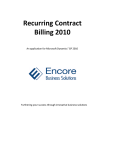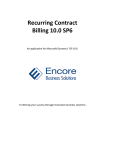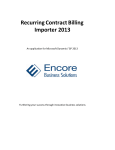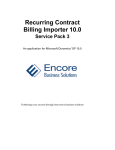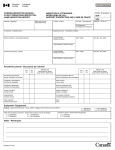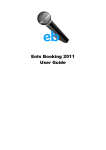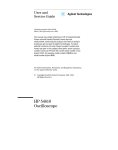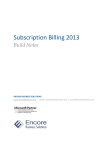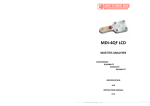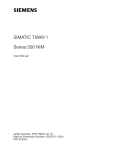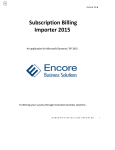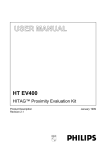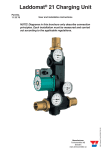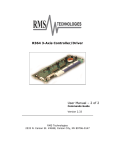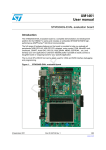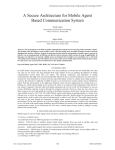Download Subscription Billing 2013 - Encore Business Solutions Inc.
Transcript
Subscription Billing 2013 An application for Microsoft Dynamics GP 2013 Furthering your success through innovative business solutions Copyright Manual copyright © 2013 Encore Business Solutions, Inc. Printed in Canada. All rights reserved. Your right to copy this documentation is limited by copyright law and the terms of the software license agreement. As the software licensee, you may make a reasonable number of copies or printouts for your own use. Making unauthorized copies, adaptations, compilations, or derivative works for commercial distribution is prohibited and constitutes a punishable violation of the law. Trademarks Microsoft, Microsoft Excel ®, and Microsoft Dynamics GP are either registered trademarks or trademarks of Microsoft Corporation or its affiliates in the United States and/or other countries. The names of actual companies and products mentioned herein may be trademarks or registered marks - in the United States and/or other countries - of their respective owners. The names of companies, products, people and/or data used in window illustrations and sample output are fictitious and are in no way intended to represent any real individual, company, product, or event, unless otherwise noted. Warranty disclaimer Encore Business Solutions Inc. disclaims any warranty regarding the sample code contained in this documentation, including the warranties of merchantability and fitness for a particular purpose. Limitation of liability The content of this manual is furnished for informational use only, is subject to change without notice, and should not be construed as a commitment by Encore Business Solutions Inc. Encore Business Solutions Inc. assumes no responsibility or liability for any errors or inaccuracies that may appear in this manual. Neither Encore Business Solutions Inc. nor anyone else who has been involved in the creation, production, or delivery of this documentation shall be liable for any indirect, incidental, special, exemplary or consequential damages, including but not limited to any loss of anticipated profit or benefits, resulting from the use of this documentation or sample code. License agreement Use of this product is covered by a license agreement provided by Encore Business Solutions Inc. If you have any questions, please call our office at 888.898.4330 (North America only). Publication Date October 2013 CONTEN T S Contents Introduction .............................................................................................................................. 2 Subscription Billing ................................................................................................................. 2 Subscription Billing Importer ............................................................................................... 3 Symbols and conventions ..................................................................................................... 4 .NET Window Standards ....................................................................................................... 4 Additional resources .............................................................................................................. 5 Support services ...................................................................................................................... 6 Chapter 1: Installation & Registration............................................................ 10 Microsoft .NET Framework installation ......................................................................... 10 Prior to Upgrading or Installing a new build ................................................................ 11 Installing Subscription Billing............................................................................................. 11 Entering registration keys................................................................................................... 12 Creating tables ....................................................................................................................... 15 Setting up security ................................................................................................................ 16 Chapter 2: Setup ................................................................................................................ 20 Setting up Subscription Billing .......................................................................................... 20 Chapter 3: Using Subscription Billing .............................................................. 28 Entering customer contracts ............................................................................................. 28 Skipping billing cycles........................................................................................................... 38 Assigning an Accounts Receivable account to contracts ......................................... 39 Editing individual line items ............................................................................................... 40 Using Subscription Billing user-defined fields.............................................................. 44 Using Sales Order Processing user-defined fields ...................................................... 45 Viewing contract document history ................................................................................ 46 Integrating with Receivables Electronic Funds Transfer (EFT) ............................... 48 Copying an existing contract ............................................................................................. 49 Creating Subscription Billing documents ....................................................................... 51 SUB SCRIPTION B ILLING iii C ONT E N T S Editing contract documents .............................................................................................. 57 Allocation and fulfillment ................................................................................................... 58 Posting invoices from Subscription Billing .................................................................... 58 Using Rollback ........................................................................................................................ 59 Running the Rollback Archive report ............................................................................. 61 Purging the rollback archive .............................................................................................. 62 Creating project distributions in Project Tracking ..................................................... 63 Adding comments to the contract .................................................................................. 65 Creating revenue/expense deferrals .............................................................................. 67 Chapter 4: Reporting ...................................................................................................... 76 Printing a Subscription Agreement ................................................................................. 76 Printing the Subscription Billing Reports ...................................................................... 77 Adding fields to Microsoft Dynamics GP reports in Report Writer ...................... 79 Setting security access for modified reports ............................................................... 85 Appendix A: Data Tables....................................................................................................... 89 What’s New in Subscription Billing for 2013 ............................................................. 91 What’s New in Recurring Contract Billing for 2010 and 2013 .......................... 91 What’s New in Recurring Contract Billing for 2010................................................ 92 What’s New In Recurring Contract Billing for 10.0 SP6........................................ 92 What’s New in Recurring Contract Billing for 10.0 SP5 ........................................ 92 What’s New in Recurring Contract Billing for 10.0 SP4 ........................................ 93 What’s New in Recurring Contract Billing for 10.0 SP2 ........................................ 93 What’s New in Recurring Contract Billing for 10.0 ................................................. 93 What’s New in Recurring Contract Billing for 9.0 Extension ............................. 93 Known Issues............................................................................................................................... 96 What’s New in Encore Products for 2013 .................................................................... 97 Documentation Feedback .................................................................................................... 97 About Encore Business Solutions ..................................................................................... 99 iv S U BS CR I P T I O N BI LLI NG INTRODUCTION Introduction Subscription Billing Subscription Billing allows you to create customer contracts with customers within your Microsoft Dynamics GP system. These contracts can include inventory and non-inventory items, a different billing frequency for each line item, and automatic payments. Subscription Billing requires minimal setup as it takes advantage of all the standard setup options from the Microsoft Dynamics GP Sales Order Processing, Receivables, Inventory, and Posting modules. The contract billing process in Subscription Billing creates batches of invoices in the Sales Order Processing module to take advantage of the standard editing, invoicing and posting functionality. Not only can Subscription Billing can be used with the Sales Order Processing module, Subscription Billing can be used with the Inventory, Multicurrency, and Revenue Expense Deferral modules. Subscription Billing will make it possible for you to: 2 S U BS CR I P T I O N • Calculate commissions using information from the customer record. • Calculate sales tax using information from the customer record. • Include customers who exceed their credit limit or put their invoices on “Process Hold”. • Include or exclude customers who are on Hold. This option can be password protected. • Include or exclude customers who are Inactive. This option can be password protected. • Include or exclude items that are discontinued. This option can be password protected. • Levy freight charges on the invoices created. BI LLI NG • Calculate payment terms based on information in the customer record. • Automatically distribute the invoices/ orders/ quote documents within Sales Order Processing, ready to be posted. • Print a Subscription Agreement which will contain contract details in a legal contract format for customer review and signature. • Create either quotes, orders or invoices for the selected contracts in the Sales Transaction Entry module. • Print an exception report that lists why certain items and/or customers were not included in the invoice batch. • Select various ranges that will determine which contracts will be billed in a given batch. • When used in conjunction with Microsoft Dynamics GP Electronic Funds Transfer (EFT) for Receivables, the Electronic Funds Transfer module (EFT) will create an EFT file to send to your bank during the invoice posting process. • The integration of Subscription Billing with Microsoft Dynamics GP Revenue/Expense Deferral module provides an automatic method of allocating sales amounts over specific time periods. • Generate project distributions when used in conjunction with Encore’s Project Tracking module. • Define contracts to be dominated in any currency. Subscription Billing Importer Subscription Billing Importer allows users to import existing contract information from an external system. This feature is great for users moving to Microsoft Dynamics GP from an older system and for those users who use an external CRM system to gather contract information. Importing is done from a simple text file, either fixed field, comma delimited, or tab SUB SCRIPTION B ILLING 3 delimited. The importer can also be used to quickly generate large numbers of contracts. The Subscription Billing Importer requires separate registration keys. For more details on importing contracts see the user manual for Subscription Billing Importer. The Subscription Billing Importer now supports the multicurrency functionality. The Currency ID can now be imported through the Subscription Importer window. The Subscription Billing Importer Windows also provides the ability to create a new contract with a different Currency ID. Both existing and creating contract lines must be considered. Symbols and conventions This user manual and the online help uses the following symbols and conventions to make important information stand out. Symbol/Convention Description The warning symbol indicates situations you should be especially aware of when completing tasks. Typically, this symbol includes cautions about performing steps in their proper order, or important reminders about how other information may be affected. The light bulb symbol indicates helpful tips, shortcuts and suggestions. File >> Print The ( >> ) symbol indicates selections to make from a menu. In this example, from the File menu, choose Print. .NET Window Standards • 4 S U BS CR I P T I O N BI LLI NG The scrolling window has been replaced by .NET grid rows. The use of grid rows allows all line item fields to be included on one row. This provides you, the user to add, remove and edit line items more ease. • All fields, including non-editable fields are available for standard copy and paste functionality using CTRL+C and CTRL+V. • Fields that are in error are easily identified by the red error indicator beside the field. When a line item has an error in any of its fields an error indicator will be displayed at the front of the line item as well as at the field in error. If the grid row view is in the single line view, expand the view so that you can see the second line for any possible errors. • To add a new value for any of the fields, select the link or zoom for that field. The link or zoom will take you to the associated maintenance or setup window for that field. • Selecting the New button will bring up a new blank contract displaying the next available contract number. • Clear a contract from the window by selecting the Clear button. If changes were made to the contract you have the option to save or discard them. • To save information that has been entered or changed on a contract you must select the Save button. Previously changes made to the contract were saved as you completed each line preventing the editing and discard functionality. • A footer toolbar on the line items tab that provides functionality such as: • VCR buttons to scroll through multiple line items. • Plus + sign icon to insert an additional line item. • Minus - sign icon to remove a selected line item. • Skip Cycle icon to skip a billing cycle for a selected line item. • Hide/ Expand icons to change the line items view from a single line to a double line. Additional resources The Subscription Billing user manual is provided in your Microsoft Dynamic GP folder in the hard copy format as an Adobe Acrobat PDF file. Online SUB SCRIPTION B ILLING 5 help is available for this version of Subscription Billing by pressing F1 on any of the Subscription Billing windows. The online help includes all the information in the user manual except the What’s New and Known Issues sections. Support services Please refer to this quick reference table when you need to use Encore’s Technical Support services. Service Contact General Calls 204.989.4330 Toll Free (North America only) 866.472.0824 Fax 204.235.2331 E-mail [email protected] www.encorebusiness.com Web Before You Call Support: You should have the answers for all of the following questions to help your support specialist quickly narrow down the source of the problem you are experiencing. 6 S U BS CR I P T I O N BI LLI NG • What is the exact error message? • When did the error first occur? • What task were you attempting to perform at the time you received the error message? • Has the task been completed successfully in the past? • What is the name of the window you are working in? • What have you done so far to attempt to fix the problem? • Have you performed any of the table maintenance procedures such as check links? • If have performed table maintenance procedures and received error messages, what kind of messages? • Does the problem occur in another company? • Does the problem occur on another workstation? • Does the problem occur for more than one user? • Have you imported any data? • What versions of software are you using? Verify the version numbers for Microsoft Dynamics GP, your database software, Encore product and Windows. Also note service packs. To locate the version number for Subscription Billing in version 2013, go to Microsoft Dynamics GP menu >> Tools >> Setup >> System >> Encore Product Registration. The About window can be located by selecting Subscription Billing and expanding the window. The About window link is located in the bottom left hand corner of the Encore Product Registration window. To locate the version number for Recurring Contract Billing in version 10.0 and 2010, go to Microsoft Dynamics GP menu >> Tools >> Setup >> System >> Encore Product Registration. The About window can be located by selecting Recurring Contract Billing and expanding the window. The About window link is located in the bottom left hand corner of the Encore Product Registration window. SUB SCRIPTION B ILLING 7 8 S U BS CR I P T I O N BI LLI NG INSTALLATION & REGISTRATION Chapter 1: Installation & Registration This chapter describes how to install, and register Subscription Billing. You will need separate registration keys to register Subscription Billing and Subscription Billing Importer. This chapter contains the following sections: • • • • • • Microsoft .NET Framework installation Prior to Upgrading or Installing a new build Installing Subscription Billing Entering registration keys Creating tables Setting up security Microsoft .NET Framework installation In order to properly execute and operate Subscription Billing, you need to install Microsoft .NET Framework version 3.5 from the Microsoft website http://www.windowsupdate.com. If you think it has been installed previously, check your Windows Control Panel (See Step #6). 1. Select the Microsoft website, http://www.windowsupdate.com, in your internet explorer. 2. Locate the download for Microsoft .NET Framework version 3.5. 3. Launch thedotnetfx.exe file by double clicking on it. This will start the installation program. 4. Follow the instructions in the installation wizard. 5. Choose OK on the message displayed when the installation is completed. 6. To ensure Microsoft .NET Framework version 3.5 has been installed check your Windows Control Panel. (Start >> Control Panel >> Add or Remove Programs) 10 S U BSCR I P T I O N BI LLI NG INSTALLATION & REGISTRATION Prior to Upgrading or Installing a new build When upgrading Subscription Billing to version 2013 from any version previous to Recurring Contract Billing version 9.0.NET including version 9.0.00.01.006, you must first upgrade to version 9.0.00.02. Extension to adapt the .NET technology. Before upgrading from an earlier version or installing a new build of Subscriptionct Billing, be sure to back up your data, especially any customized reports/windows. Once your backup files have been created you can complete the installation and setup procedures described in this manual. To create a backup file of your customized reports/ windows: 1. Open the Customization Maintenance window. (Microsoft GP>>Tools>>Customize>>Customization Maintenance) 2. Locate the customized Encore product in the Product column. 3. Highlight all the Modified Reports/Windows in the list. 4. Click on Export. 5. Enter a name for the file. 6. Select a folder location to save the package to. Installing Subscription Billing You will use the installation program to install Subscription Billing. Before you begin installing, do the following: • Note the directory location of your Microsoft Dynamics GP installation. You will need this information during the installation. • Verify that the SB12.00.01.xxx.exe file has been loaded on to your computer. (The x’s in the file name will be replaced with numbers.) SUB SCRIPTION B ILLING 11 INS T AL LAT I O N & R E GI S T R ATION • Create a backup of your Microsoft Dynamics GP data before installing Subscription Billing. • Exit all applications. To install Subscription Billing: 1. Open Windows Explorer and locate the SB12.00.01.xxx.exe file. The location of this file will vary depending on how you acquired the application. (The x’s in the file name will be replaced with numbers.) 2. Launch the SB12.00.01.xxx.exe file by double-clicking it. The installation program for Subscription Billing will start. 3. Follow the instructions in each window. 4. After the installation is complete, start Microsoft Dynamics GP. You will receive the following message. 5. Select Yes. Information for Subscription Billing and Encore Product Registration will be included in the Dynamics.set file. Entering registration keys Before you can use Subscription Billing with your company data, you must register your software. To register your software enter the product registration key or the drop file provided to you by Encore. If you choose not to enter the registration information, you will only be able to create sample transactions using Fabrikam Inc - the lesson company. 12 S U BS CR I P T I O N BI LLI NG INSTALLATION & REGISTRATION To register your product: 1. Open the Encore Product Registration window. (Microsoft Dynamics GP menu >> Tools >> Setup >> System >> Encore Product Registration) 2. Highlight Subscription Billing for SOP.. 3. Choose the show detail expansion button to display the detailed view of the registration window. SUB SCRIPTION B ILLING 13 INS T AL LAT I O N & R E GI S T R ATION 4. Enter the product registration key provided by Encore. 5. If you have purchased more than one Subscription Billing product, repeat steps 2 to 4 until all your purchased products are registered. 6. Select the About zoom field to open the About window for this product. This window contains the version number for this product and information on how to contact Encore. 7. Select OK to close the window. To register your product using a drop file: 1. Copy or save the drop file to the directory location for your Microsoft Dynamics GP. For Example: C:\ Microsoft Dynamics GP\ 2. Log in to Microsoft Dynamics GP as a system administrator. 3. The system will notify you that it has found a registration file, accept the prompt. 14 S U BS CR I P T I O N BI LLI NG INSTALLATION & REGISTRATION 4. The system will notify you when the product has been registered. 5. Open the Encore Product Registration window to ensure that it has been registered. (Microsoft Dynamics GP menu >> Tools >> Setup >> System >> Encore Product Registration) Creating tables Whether you want to demo or run the product, you must run the Table Conversion/Upgrade process to create tables—this will set up SQL components and convert any existing data. You must log in as System Administrator to run the Table Conversion/Upgrade process. To create tables: 1. Open the Table Conversion window. (Microsoft Dynamics GP menu >> Maintenance >> Subscription Billing >> Table Conversion) 2. Select Process. Tables will be created, permissions will be set, and existing data will be converted. 3. Run the Checklinks process only when experiencing slowdown issues with the Subscription Billing module. Every time you install Subscription Billing, you must run the Table Conversion/ Upgrade process for each company. Companies that have a large volume of records may take an extended period of time to run the table conversion process. SUB SCRIPTION B ILLING 15 INS T AL LAT I O N & R E GI S T R ATION Setting up security For basic security instructions, please refer to Assigning security in Microsoft Dynamics GPs documentation. For Subscription Billing, you must assign the Subscription Billings windows and reports to a security task, and then assign the security task to a specific role in your company. To assign the Subscription Billing windows and reports to a security task: 1. Open the Security Task Setup window. (Tools>>Setup>>System>>Security>>Security Tasks) 2. Create a new Task ID, or select an existing Task ID. 3. From the Product list, select Subscription Billing. 16 S U BS CR I P T I O N BI LLI NG INSTALLATION & REGISTRATION 4. From the Type list, select Windows (or Reports). 5. From the Series list, select 3rd Party. 6. To select all of the operations, click Mark All, or select the applicable operations. 7. Click Save. 8. Repeat this procedure selecting Reports from the Type list. To assign the security tasks to a role: 1. Open the Security Role Setup window. (Tools>>Setup>>System>>Security>>Security Roles) 2. Select a Role ID. 3. To select all of the operations, click Mark All, or select the applicable operations. SUB SCRIPTION B ILLING 17 INS T ALLAT I O N & R E GI ST R ATION 4. Click Save. 18 S U BSCR I P T I O N BI LLI NG SETUP Chapter 2: Setup This chapter describes how to set up Subscription Billing. Setting up Subscription Billing The Subscription Billing Setup Options window has been separated into three different tabs to provide options to setup Subscription Billing to be more meaningful to your company: • Contract tab - The Contract tab allows you to setup: • A contract number sequence • How to prorate time periods • How to round prorated amounts for your contracts • Determine whether you want to enable rollback or not • Select whether to get warnings when changes have been made to the customer card. • Billing tab - The Billing tab allows you to setup the process hold ID option, change item description, set deferral option - create previous closed periods in first open periods, and establish passwords to prevent users from creating invoices for: • Customers at or above their credit limit • Customers on hold • Inactive customers • Discontinued items • User-Defined tab - Provides 16 user-defined fields to be used for the contract header and 8 user-defined fields to be used for the contract lines: • 4 Text for header, 2 for lines • 4 Date for header, 2 for lines • 4 Numeric for header, 2 for lines • 4 Check Box for header, 2 for lines This chapter includes the following topics: • • 20 S U BSCR I P T I O N BI LLI NG To set up Subscription Billing - Contract Tab: To set up Subscription Billing - Billing Tab: SET U P • To set up Subscription Billing - User-Defined Tab: To set up Subscription Billing - Contract Tab: 1. Open the Subscription Billing Setup Options window. (Microsoft Dynamics GP menu >> Tools >> Setup >> Sales >> Subscription Billing >> Contract Tab). 2. Enter the contract number that you would like to use. This can be any alphanumeric string, up to 20 characters long. Leave leading zeros and make the number long enough to be incremented as the system will not add digits. To use a contract number that can’t be incremented, such as an alpha only number, enter it in the Subscription Entry window. 3. To enable the rollback feature that allows you to delete invoices prior to posting and rollback contracts to their status prior to the creation of those invoices, mark the Enable Rollback check box. For more information about the rollback feature, see To rollback contracts:. SUB SCRIPTION B ILLING 21 S E T U P 4. Choose whether or not to update customer information on recurring billing contracts whenever changes are made to the Customer Card. You may select Never, Always, or Ask Each Time. 5. Choose whether or not to update item information on contracts whenever changes are made to the Item Card. Choose from-Never, Always, or Ask Each Time. 6. Mark the Prorating check box to prorate billing if your company needs to prorate billings. 7. Under the Time Period option, select either a time period of Days or Months. Note: Prorating by Days is only available if you are using a billing interval longer than Monthly. It is calculated as follows: # of days billed divided by # of days in period. When an option to prorate billings is selected, the amount invoiced from contract line items which have a frequency of weekly, bi-weekly, monthly, bimonthly, quarterly, semi-annually or annually (not user defined or one-time) can be prorated for the first and last billing. 8. Under the Time Period option, choose an option for partial months rounding: • • • Up (the amount invoiced is always rounded up) Down (the amount invoiced is always rounded down) To Nearest (the amount invoiced is rounded to the nearest currency unit) 9. Under the Prorated Amount option, if rounding to the nearest currency unit, enter the Round to Multiple amount. (e.g., to the nearest $0.01, $0.25, or $1.00). 10. From the Prorated Amount, select one of the following options for Partial Multiple Rounding: • • • 22 S U BS CR I P T I O N BI LLI NG No Prorating Up (additional months will be added to the initial bill) Down (first additional month is disregarded in the initial bill) SET U P • Nearest (if the Start Date is more than midway through the month, the month is disregarded; if the Start Date is midway or earlier, the month is added to the initial bill). The Partial Months Rounding list is only available when the Months option is selected from the Prorate Based on list. 11. Select OK. To set up Subscription Billing - Billing Tab: 1. Open the Subscription Billing Setup Options window. (Microsoft Dynamics GP menu >> Tools >> Setup >> Sales >> Subscription Billing >> Billing Tab) Refer to the Microsoft Dynamics GP documentation for instructions on creating a Process Hold record. 2. To prevent users from processing Sales Order Processing invoices that cause customers to exceed their credit limits, select a Process Hold ID that has a password set up in the Sales Process Holds Setup window. This will ensure that the user must enter the correct password before selecting the Exceed Credit Limit option. An error will be generated if a process hold ID is not selected. 3. Change Item Description to determine what information is input into the Item Description field when the SOP document is created from Subscription Billing. Select option: SUB SCRIPTION B ILLING 23 S E T U P • • • • • Item Description: Normal default - uses the description from the Item Cards. Billing Date Range: Displays the date range covered by the billing. The start date of the range is based on the next billing date. The end date of the range is based on the billing frequency. (The dates of the range will be adjusted if the prorate option is marked) Item Description and Billing date: Includes both the item description and billing date range options. Service Date (deferrals): Displays the date range covered by the billing but is based on the service date which is used when line level deferrals is used. The start of the range is the Service date. The end date of the range is based on the billing frequency. (The dates of the range will be adjusted if the prorate option is marked Item Description and Service date: Includes both the item description and service date range options. 4. Mark the check box for deferrals - create previous closed periods in first open period. If checked and using deferrals, if the deferral distribution is for a date prior to the current date, the date will be changed to the first open fiscal period. The Distribution reference will indicate what the original date was. 5. To prevent users from creating invoices for customers who are on hold, enter a password. This password will be required to process customers who are on hold. 6. To prevent users from creating invoices for customers who are inactive, enter a password. This password will be required to process customers who are inactive. 7. To allow users to include discontinued items in invoices, enter a password. If you do not enter a password in the Process Discontinued Items field, Subscription Billing will automatically exclude discontinued items during invoice creation. 8. Select OK. 24 S U BSCR I P T I O N BI LLI NG SET U P To set up Subscription Billing - User-Defined Tab: 1. Open the Subscription Billing Setup Options window. (Microsoft Dynamics GP menu >> Tools >> Setup >> Sales >> Subscription Billing >> User-Defined Tab). 2. Choose the Text Fields tab to enter labels for the text user-defined fields for the contract header and contract lines. 3. Choose the Date Fields tab to enter labels for the date user-defined fields for the contract header and contract lines. 4. Choose the Numeric Fields tab to enter labels for the numeric userdefined fields for the contract header and contract lines. 5. Choose the Check Box Fields tab to enter labels for the check box userdefined fields for the contract header and contract lines. 6. Select OK. SUB SCRIPTION B ILLING 25 S E T U P 26 S U BSCR I P T I O N BI LLI NG USING SUBSCRIPTION BILLING Chapter 3: Using Subscription Billing Subscription Billing allows you to create contracts in Microsoft Dynamics GP that will generate invoices, quotes or orders at regular intervals. This chapter includes the following topics: • • • • • • • • • • • • • • • • • • • Entering customer contracts Skipping billing cycles Assigning an Accounts Receivable account to contracts Editing individual line items Using Subscription Billing user-defined fields Using Sales Order Processing user-defined fields Viewing contract document history Integrating with Receivables Electronic Funds Transfer (EFT) Copying an existing contract Creating Subscription Billing documents Editing contract documents Allocation and fulfillment Posting invoices from Subscription Billing Using Rollback Running the Rollback Archive report Purging the rollback archive Creating project distributions in Project Tracking Adding comments to the contract Creating revenue/expense deferrals Entering customer contracts Every contract that you create will be assigned a Customer ID and may include inventory and non-inventory line items with differing billing frequencies, unit prices and quantities. Based on the information you enter, invoices for items that are due to be billed will automatically be created as part of the create documents process. For more information about the create document process, see Creating Subscription Billing documents on page 51. 28 S U BS CR I P T I O N BI LLI NG USING SUB SCRIPTION B ILLIN G Make sure you have completed the setup as described in Setting up Subscription Billing on page 20. Once the setup is complete, you are ready to enter customer contracts. To enter customer contracts - contract header: 1. Open the Subscription Billing Contract Entry window. (Transactions >> Sales >> Subscription Billing Contract Entry) 2. Enter or select a contract number or accept the default entry. If a change needs to be made to the contract number format you can select Contract Numbering from the Additional menu or CTRL+N which will take you to the Subscription Billing Setup Options window. A unique contract number can be entered here but depending on the format Subscription Billing may not be able to increment it. 3. Enter the Customer ID. Information from the customer record such as address, salesperson, sales territory, commission, payment terms, currency id, distribution account SUB SCRIPTION B ILLING 29 U S ING S U BSCR I P T I O N BI LLI NG numbers, etc. will be used to create the invoice. Commission is calculated on the invoice total only. All setup for Currency ID will be done in the Dynamics GP multicurrency windows (Tools >> Setup >> Financial >> Multicurrency). 4. To group your recurring contracts into different classes, enter a contract class. 5. Accept the default Site ID or select a different one. 6. If desired, enter a PO Number and the PO Date. 7. In the General tab, select a contract status. Contracts with a status of Inactive or Hold will not be billed. 8. Select the Currency ID if you want to use different currency for the contract. The currency fields will be formatted using the currency selected for the contract. If a currency has not been selected for the contract, the functional currency will be used. Multicurrency functionality is only available if you are using the Sales Order Processing Module. 9. The Contract Summary fields will be populated based on the information entered for the line items. • The frequency field will be populated with the most granular frequency entered for all of the line items. • The Start date and the Next Date to Bill will be populated with the earliest date for all of the line items. • The End date and the Last Date Billed will be populated with the latest date for all of the line items. • The Continuous Billing field will default as marked if a line item has been marked as continuous billing in the Line Item Detail window. 10. Select the Line Items tab. 30 S U BS CR I P T I O N BI LLI NG USING SUB SCRIPTION B ILLIN G 11. Enter all the items to be invoiced to the customer on this contract. • If the item is inventoried, enter or select the item number, unit of measure, item quantity, and price level for the invoice. Any inventory item that is included in an active contract cannot be deleted from Microsoft Dynamics GP. If you need to delete an inventory item that is on an active contract, delete the item from the contract first before deleting it from Microsoft Dynamics GP. • If the item is non-inventoried enter the item number, unit price, and the quantity. The CP (Contracted Price) check box will automatically be marked. To update the price of a non-inventoried item, you must edit the price on the contract. 12. To keep an item at a static price, mark the CP (Contracted Price) check box. When the CP check box is marked, all price levels are disabled and all price changes must be entered manually. If you leave the Contracted Price check box unmarked, price level pricing at the time of invoice creation will override the unit price entered in this window. Notes: Changes made to the price levels will be reflected on the contract as the changes are made. 13. Enter a markdown amount. SUB SCRIPTION B ILLING 31 U S ING S U BSCR I P T I O N BI LLI NG • To enter a markdown as a percentage, choose the Markdown expansion button. The Contract Markdown Entry window will open. Mark the percentage option and enter the percentage amount. A markdown can not be specified for a line item that has been entered with a negative price. 32 S U BS CR I P T I O N BI LLI NG USING SUB SCRIPTION B ILLIN G 14. Select a billing frequency. It will be the default billing frequency for all the line items on the contract. However, each line item can have its own billing frequency. The billing cycle for the contract will be based on the line item with the most frequent billing cycle. For example, if a contract has one line item with a weekly billing frequency and the rest of the line items on the contract have a monthly billing frequency, the billing cycle will be based on weekly billings. If you chose a billing frequency of UD-Days or UD-Months, enter the number of days/months between billings in the corresponding UDDays/UD-Months field. Use the UD-Months frequency option to bill for frequencies that exceed Annual. 15. Enter the Comment ID—the comment will display as the default comment in the Line Item Detail window. If a comment ID is entered, the comment ID and text will be used when the SOP invoice is created. Changes to the text of that comment ID in the Comment Setup window will be carried through to the contract. Changes made to the comment within the contract using the Contract Comment Entry window will be retained permanently. An icon will be displayed to indicate that the comment has been changed. 16. Enter the billing start date—the start date for the first billing cycle. 17. Enter the billing end date—the date the contract will terminate. If an end date is not entered, this line item will be billed indefinitely. This is optional. Take care that you do not inadvertently miss the last billing cycle when entering a billing end date. For instance, if you have a monthly contract that is to last for one year, you must enter an end date that is exactly a year after that start date. If Continuous Billing has been marked for a line item, in the Line Item Detail window, the line item will continue to bill past the entered end date. 18. Enter the next scheduled billing date or accept the default value. • If you must edit the Next Date to Bill, be VERY careful. Errors may result in missed billings. The system uses the Next Date to Bill to SUB SCRIPTION B ILLING 33 U S ING S U BSCR I P T I O N BI LLI NG determine when recurring contract line items are eligible for invoicing, then automatically updates the Next Date to Bill field once an invoice has been created. When creating invoices, the Due Date on the Create Recurring Documents window is compared to this date. If the Next Date to Bill is equal to or prior to the Due Date on the Create Documents window, an invoice will be created from this contract. 19. If you choose a billing frequency of monthly, bimonthly, quarterly, semiannually, or annually, select a billing day. Select End of Month to give true end of month billing. 20. If the revenue from the item is to be deferred, please refer to Creating revenue/expense deferrals on page 67 for instructions. The footer toolbar on the line items tab provides functionality such as: •VCR buttons to help scroll through multiple line items. •Plus + sign icon to insert an additional line item. •Minus - sign icon to remove a selected line item. When editing a line the Minus sign icon will be greyed out. Before you can delete the line press ESC to escape the line or ENTER to save the line. •Skip Cycle icon to skip a billing cycle for a selected line item. •Hide/ Expand icons to change the line item view from single line to double line. 21. Select the Options tab. This tab contains fields that will be populated from the Microsoft Dynamics GP customer card. Any changes made to the fields would only affect the current contract. • 34 S U BS CR I P T I O N BI LLI NG If the option to Update Contract when Customer Card changes is marked in the Subscription Billing Setup Options window, and if payment terms are updated on the customer card, the payment terms on the contract will be updated as well. USING SUB SCRIPTION B ILLIN G 22. Select a payment term which will be specific to the contract. This is optional. 23. To print a comment on the contract, select the Comment ID from the Comments lookup window or choose the Comment ID expansion button to create a one-time comment. For more information about adding comments, see Adding comments to the contract on page 65. 24. The Deferral Profile Group attaches deferral profiles, established in the Microsoft Dynamics GP Revenue Expense Deferral module, to the line items on the contract. Deferrals can be specified for each line item on the contact. For more information about creating deferrals, see Creating revenue/ expense deferrals on page 67. 25. If a Electronic Funds Transfer (EFT) payment record is to be created along with the invoice, select an EFT option from the Auto Payment Type drop-down list. See Integrating with Receivables Electronic Funds Transfer (EFT) on page 48 for more information. SUB SCRIPTION B ILLING 35 U S ING S U BSCR I P T I O N BI LLI NG If you integrate Subscription Billing with a credit card processing module, you will need to contact the company providing the credit card integration (For Example; Nodus or Azox). 26. Enter an Accounts Receivable account which will be specific for this contract or leave it blank to use the default set up for the company. See Assigning an Accounts Receivable account to contracts on page 39 for more information. 27. Enter a Bill to Address which will be specific for this contract or retain the default. 28. Enter a Ship to Address account which will be specific for this contract or retain the default. Taxes in Sales Order Processing can be affected by the ship-to address that you select. Each address code may have an associated tax schedule ID that will override the tax schedule ID from the customer card. The shipping method associated with the address code can also affect the selection of tax schedules. Please refer to the Microsoft Dynamics GP Sales Order Processing documentation for more information. 29. Enter a Salesperson ID which will be specific for this contract or retain the default. 30. Enter a Sales Territory which will be specific for this contract or retain the default. 31. Enter a Trade Discount, Freight, and Miscellaneous charge for this contract if applicable. These amounts will appear on all documents created from this contract. 36 S U BS CR I P T I O N BI LLI NG USING SUB SCRIPTION B ILLIN G 32. (Optional) To assign user-defined fields to line items, highlight an item and expand the view. Select the User-Defined tab (on the Line Items tab). Use these fields for informational purposes only; the data is not sent to SOP. 33. Choose the Contract Fields tab to enter Subscription Billing Userdefined values. See Using Subscription Billing user-defined fields on page 44 for further information. 34. Choose the Sales Fields tab to enter Sales Order Processing UserDefined values. See Using Sales Order Processing user-defined fields on page 45 for further information. SUB SCRIPTION B ILLING 37 U S ING S U BSCR I P T I O N BI LLI NG 35. Select Save at any time during the contract entry process to save the entries that have been made. The status of the contract will be changed to saved when the save button is selected. Skipping billing cycles When all items on the contract have the same billing frequencies, you may use the Skip Cycle button on the tool bar header of the Subscription Billing Contract Entry window to skip a billing cycle. If the recurring billing frequencies differ per line item, then you must use the Skip Cycle icon on the footer tool bar of the Line Item tab. When a cycle has been skipped for line items that have an end date, you will have to manually change the end date to reflect the new date if you want the client to be billed for the missed cycle. To skip a billing cycle for an entire contract: 1. Open the Subscription Billing Contract Entry window. (Transactions >> Sales >> Subscription Billing Contract Entry) 2. Enter or choose a contract. 3. Select the Skip Cycle button 38 S U BS CR I P T I O N BI LLI NG . USING SUB SCRIPTION B ILLIN G 4. Select Skip on the message. The Next Date to Bill will move ahead as per the billing frequency. To skip a billing cycle for a line item: 1. Open the Subscription Billing Contract Entry window. (Transactions >> Sales >> Subscription Billing Contract Entry) 2. Enter or choose a contract. 3. Select the Line Item tab. 4. Choose the line item you want to skip a billing cycle for. 5. Select the Skip Cycle icon Entry footer toolbar. on the Subscription Billing Contract 6. Select Skip on message. The Next Date to Bill will move ahead as per the selected billing frequency for the selected line item. Assigning an Accounts Receivable account to contracts You can assign a specific Accounts Receivable account number to contracts in the Subscription Entry Options tab. When you create documents for this contract, the account that you select will be used. To assign an Accounts Receivable account to contracts: 1. Open the Subscription Billing Contract Entry window. (Transactions >> Sales >> Subscription Billing Contract Entry) 2. Enter or choose a contract. 3. Choose the Options tab. SUB SCRIPTION B ILLING 39 U S ING S U BSCR I P T I O N BI LLI NG 4. Enter or select an Accounts Receivable account. If the option to Update Contract when Customer Card changes is marked in the Subscription Billing Setup Options window, and if the account number is updated on the customer card, the account number on the contract will be updated as well. 5. Select Save. Editing individual line items Individual line items can be edited using the Subscription Entry Line Item tab or the Line Item Detail window. Fields that are not on the Line Item tab such as continuous billing and payments can be edited for each line item using the Line Item Detail window. To edit line items using the Line Item Detail window: 1. Open the Subscription Billing Contract Entry window. (Transactions >> Sales >> Subscription Billing Contract Entry) 2. Enter or select the contract number. 40 S U BS CR I P T I O N BI LLI NG USING SUB SCRIPTION B ILLIN G 3. Choose the Line Items tab. Clicking the + (plus) sign next to the item number displays some of the same information that appears in the Line Item Detail window. These details can be edited here as well. SUB SCRIPTION B ILLING 41 U S ING S U BSCR I P T I O N BI LLI NG 4. Highlight the line item and then click the Item Number expansion box. The Line Item Detail window will open. 5. If desired, edit the line item data: description, site, pricing, quantity, contracted price, etc. You can edit the Site ID for specific inventoried line items here; the Site ID field in the Subscription Entry General tab applies to the contract not to individual line items. 6. To print a comment on the contract, select the Comment ID from the Comments lookup window or choose the Comment ID expansion button to create the one-time comment. For more information about adding comments, see Adding comments to the contract on page 65. 42 S U BS CR I P T I O N BI LLI NG USING SUB SCRIPTION B ILLIN G 7. The Ship to Address ID, Shipping Method, and Tax Schedule can now be included for each line item on a contract. If desired, select a value for these fields. If these field are left empty in the Line Item Detail window, the values will default to those defined on the customer card, when the document is created. 8. Change the line billing frequency for this line item. The billing cycle in the summary information on the General tab will be based on the line item with the most frequent billing cycle. For example, if you have one line item that has a weekly billing frequency and the rest of the line items are monthly, the billing cycle will be based on weekly billings. 9. Enter a monthly billing day to bill on the same day of each month. You can also select End of Month to give true end of month billing. 10. To bill every set number of days, choose User-Defined as the billing frequency. When you chose User-Defined as the frequency, enter the number of days between billings in the User-Defined # of Days field. 11. To bill the selected line item a specific number of times, enter the number of required payments in the Payments field. 12. Enter the billing start date for this item. Each item can have a different start and end billing date. 13. If desired, enter a billing end date for this item. If no end date is entered, this line item will be billed indefinitely. Take care that you do not inadvertently miss the last billing cycle. For instance, if you have a monthly contract that is to last for one year, you must enter an end date that is exactly a year after that start date. 14. If you must edit the Next Date to Bill, be VERY careful. Errors may result in missed billings. The system uses the Next Date to Bill to determine when Subscription Billing line items are eligible for invoicing, then automatically updates the Next Date to Bill field once an invoice has been created. The date entered in this field will be the next billed date used as you create the contract line items. SUB SCRIPTION B ILLING 43 U S ING S U BSCR I P T I O N BI LLI NG When an order or a quote is created the next date to bill date will update accordingly. 15. To continue to bill a line item past the end date entered for the line item, mark the Continuous Billing check box. 16. To override the default distribution accounts displayed, enter or select accounts in the Default Account Override fields. To accept the default distribution accounts, leave the override fields blank. 17. Select Save. To delete line items from a contract: Select the line item and click the minus VCR button. When editing a field, the Delete Line Item VCR button will be greyed out. Before deleting the line press ESC to escape the line or Enter to save the line. Using Subscription Billing user-defined fields There are sixteen user-defined fields available for Subscription Billing. The labels for these fields are entered in the Subscription Billing Setup Options window. The values that you enter for these user-defined fields can be added onto the Subscription Contract Agreement template using Report Writer. To enter values for Subscription Billing user-defined fields: 1. Open the Subscription Billing Contract Entry window. (Transactions >> Sales >> Subscription Billing Contract Entry) 2. Enter or select a contract. 3. Choose the User-Defined tab. 44 S U BS CR I P T I O N BI LLI NG USING SUB SCRIPTION B ILLIN G 4. Choose the Contract Fields tab. 5. Enter values for the Contract user-defined fields as required. 6. Select Save. Using Sales Order Processing user-defined fields There are ten user-defined fields available in Subscription Billing that are setup in the Sales Order Processing system. (Tools >> Setup >> Sales >> Sales Order Processing >> User-Defined button) Any values you enter for those fields in the User-Defined tab on the Subscription Entry window will be transmitted to the corresponding user-defined field on the Sales Order Processing documents. To view these fields on reports, you must add the fields to the desired reports using Report Writer. See Adding fields to Microsoft Dynamics GP reports in Report Writer on page 79. SUB SCRIPTION B ILLING 45 U S ING S U BSCR I P T I O N BI LLI NG To enter values for user-defined fields: 1. Open the Subscription Billing Contract Entry window. (Transactions >> Sales >> Subscription Billing Contract Entry) 2. Enter or select a contract. 3. Choose the User-Defined tab. 4. Choose the Sales Fields tab. 5. Enter values for the Sales Order Processing user-defined fields you want to see on the documents. 6. Select Save. Viewing contract document history The Subscription Billing Document History window displays all the documents that have been created for the selected contract. If a deferral was created for the selected contract, the deferral document will also be available. If no recurring documents have been created, the window will be empty. 46 S U BS CR I P T I O N BI LLI NG USING SUB SCRIPTION B ILLIN G To view contract invoices: 1. Open the Subscription Billing Contract Entry window. (Transactions >> Sales >> Subscription Billing Contract Entry >> Document History button) or (Inquiry >> Sales >> Subscription Billing Document History) 2. Enter or select a contract. 3. To change the currency view of a contract to either functional or originating select the Currency list button. 4. Highlight a document and select the Document Number zoom to view the details of the selected document. SUB SCRIPTION B ILLING 47 U S ING S U BSCR I P T I O N BI LLI NG 5. To view the line item details of the contract, highlight a document line and choose the Line Items button. Integrating with Receivables Electronic Funds Transfer (EFT) If you are using the Electronic Funds Transfer or eBanking module and you have Subscription Billing set up to use EFT, then an EFT file will be created to send to your bank . To view individual EFT payments that were created during the invoicing process open the Sales Payment Entry window which is available when you have selected a Sales Order Processing invoice. Refer to the Microsoft Dynamics GP Receivables Electronic Fund Transfer documentation for EFT setup information. To set up EFT: 1. Open the Subscription Billing Contract Entry window. (Transactions >> Sales >> Subscription Billing Contract Entry) 2. Enter or select a contract. 3. Select the Options tab. 48 S U BS CR I P T I O N BI LLI NG USING SUB SCRIPTION B ILLIN G 4. Choose an EFT option from the Auto Payment Type drop-down list. Microsoft Dynamics GP eBanking module must be installed for EFT to be activated. 5. Select Save. Copying an existing contract If a contract exists that is similar to one you are creating, you can copy the existing contract and use it as a template for the new contract. Please note that only active lines will be copied. To copy a current contract: 1. Open the Create Subscription Billing Documents window. (Transactions >> Sales >> Create Subscription Billing Documents). SUB SCRIPTION B ILLING 49 U S ING S U BSCR I P T I O N BI LLI NG 2. Enter the Customer ID, and then click Copy. The Copy a Contract window opens. 3. Under Source Contract, select the contract number you want to copy. 4. Select from the following options those that apply to the new contract: • Use the Price Level assigned to the Target Customer • Use Ship-To-Address, Ship Method, and Tax ID from Customer Card • Use System Date for Start Date and Next Bill Date • Clear End Date • Copy Line Comments 5. Click Copy. 6. To view the copied contract and the added lines, reselect the contract. 50 S U BS CR I P T I O N BI LLI NG USING SUB SCRIPTION B ILLIN G Creating Subscription Billing documents A fast-create feature is available, by request only, for customers who generate very large batches of SOP documents using Subscription Billing. To access this feature, please contact your Encore Business Solutions representative. The Subscription Billing create documents process allows you to create quotes, orders or invoices. The type of document you create from your contract is determined by the SOP type that is selected. In order to differentiate between the types of document (quote, order or invoice) you want to create in a batch, assign a specific contract class to each contract. Sales order documents are created based on the information entered in the Subscription Billing Contract Entry window. How often you run this process depends on the line item billing frequency for the items on your contract and your company’s business practices. If there is more than one type of frequency, then you must run the contract creation process based on the shortest frequency selected. The options and ranges you select, plus the frequency and dates entered for each line item in the Subscription Billing Contract Entry window will determine which customers and which items are included in this invoice-creation run. For example, if some items have a frequency of weekly and some have a frequency of monthly, then you must run the create recurring documents process weekly. Subscription Billing tracks which contracts and line items are due for billing, and using the ranges and selections you enter, creates documents only for those that are due. When multicurrency is being used the applicable exchange rate will be calculated when a SOP document is created. Be sure to set up default account numbers for each of your customers and for each of your posting accounts. Refer to Sales Order Processing documentation for instructions. Before you can run the creation process, make sure you have completed the installation and setup instructions described in previous sections. You cannot create recurring documents for a contract that has an unposted invoice. We strongly recommend the use of a distinct Type ID to prevent numbering problems that may occur in multi-user situations. SUB SCRIPTION B ILLING 51 U S ING S U BSCR I P T I O N BI LLI NG To create a batch of Subscription Billing documents: 1. 52 S U BS CR I P T I O N BI LLI NG Open the Create Subscription Billing Documents window. (Transactions >> Sales >> Create Subscription Billing Documents) USING SUB SCRIPTION B ILLIN G 2. The Selection Template field allows you to setup templates to streamline Subscription Billing create process. Click on the blue expansion error to open the Create Subscription Billing Documents Selection Template window. 3. Select the Sales Order Processing module from the Module dropdown list. Only the SOP module supports multicurrency functionality. 4. Choose a document type (either invoice, order or quote) to create the preferred document. 5. Choose the Type ID. This is the “Fulfillment Order/Invoice ID” from Sales Order Processing SUB SCRIPTION B ILLING 53 U S ING S U BSCR I P T I O N BI LLI NG 6. Enter the Billing Due Date—the cut-off date for billing contracts. Only those contracts with a next billing date on or before this date will be created. For contracts with varying billing due dates for line items, only the line items due on or before this date will appear on the contract bills. 7. Enter or accept the Document Date—this is the date that will be used when the documents are created. 8. When using deferral profiles as set up on the Subscription Billing Contract Entry window - Options tab, A Start Date if Not on Profile will default from the document date. This field can be different from the document date to be more specific if required. This field not used when using Line Level Deferrals. 9. Enter a Batch Number—you can assign an existing batch for all the documents that will be created or you can create a new batch. 10. You may choose to enter a GL Reference. This GL reference will be used if you have not assigned a GL reference to the contract on the General tab. The GL Reference will show up on the Reference field in the (GL) Journal Entry after the SOP documents have been created and after it has been posted in SOP. When you use an existing batch for the invoice, the GL Reference can be very handy to distinguish the invoices created by this process. 11. Select a Sort Order: by Customer ID, or by Contract Class. The sort order you select will be the order in which the documents will be created. 12. To limit the documents being created, enter ranges for the various categories listed. Only those due-for-billing contracts that fall within all entered ranges will be created. The following categories are available: • Contract Class • Contract Number • Customer Class • Customer ID 54 S U BS CR I P T I O N BI LLI NG USING • • SUB SCRIPTION B ILLIN G Item Number—if a contract has an Item Number within this range, ALL items on the Contract will be billed Territory—contracts and line items within the specified territory range will be billed; any line items whose Sales Territory falls outside of the range will not be included. 13. To restrict the documents created by user-defined fields, choose the User-Defined Ranges button to open the User-Defined Ranges window. Enter any ranges that apply. Access setup for the SOP User-Defined Fields and Dates by choosing: Microsoft Dynamics GP menu >> Tools >> Setup >> Sales >> Sales Order Processing >> User-Defined. Access setup for the Customer User-Defined fields by choosing: Microsoft Dynamics GP menu >> Tools >> Setup >> Sales >> Receivables >> Options. SUB SCRIPTION B ILLING 55 U S ING S U BSCR I P T I O N BI LLI NG 14. If desired, mark the check boxes that will allow you to exceed the credit limit, include customers on hold, include inactive customers, or to include discontinued items. If you want users to be required to enter a password to be able to use these overrides, enter the passwords. Note: These passwords are defined in the Subscription Billing Setup Options window. 15. If making a template save your changes. On the Create Subscription Billing Docuemnts window select the template or enter criteria as per the above instructions. 16. Choose Create—this will begin the create routine. The Batch Progress window will open once the selection process is completed. The number of contracts selected to be processed will appear in the Total Records Selected field. 17. To preview or print a report listing the contracts selected, choose the Report button. The Detail report will list the contracts to be processed as well as the line item details. To print a summary report without the line item details, uncheck the Create Detailed Edit Report option on the Create Subscription Billing Documents window and then choose the Report button on the Batch Progress window. If the Total Records Selected is large, you may wish to interrupt the batch creation process before it is completed. To interrupt the batch creation process, set a Break At Record Number figure that is less than the Total 56 S U BS CR I P T I O N BI LLI NG USING SUB SCRIPTION B ILLIN G Records Selected. When that number is reached, the process will be interrupted, and you will then have the option of canceling the remaining contracts or continuing the batch. If you don’t want to interrupt the batch creation process, leave the Break at Record number field set to 0. 18. Choose Create to print the selected contracts. After the documents are created, a report will the generated detailing that were created. Use the document numbers on this report to view or edit any documents in the appropriate Microsoft Dynamics GP sales entry window. 19. To view the first document that was created by a batch, choose the Transactions button. 20. To print an Exceptions report, choose Exceptions. This report lists only those contracts that were due to be processed but exceptioned out. A short description is provided of why the document was not generated. Editing contract documents If necessary, you can edit the documents that were created from Subscription Billing in the Sales Transaction Entry window. Invoices must be edited before they are posted. Use the Invoices Created report, available from the Create Subscription Billing Document window after the batch has been created, to identify which documents were created by Subscription Billing. To edit a document: 1. Open the Sales Order Processing Entry window. (Transactions >> Sales >> Sales Transaction Entry) 2. In the Sales Transaction Entry window choose a Type ID. 3. Choose or enter a document number. 4. Edit the document as required. SUB SCRIPTION B ILLING 57 U S ING S U BSCR I P T I O N BI LLI NG 5. Select save. You can use the link from the invoice window to the corresponding contract by choosing Additional >> Go to Subscription Entry CTRL+G. Allocation and fulfillment The allocation and fulfillment process in Sales Order Processing depends on how your Document ID is set up in the Sales Order Setup window. If the invoice or order that you’re using is set up to use a separate fulfillment process, then you will need to manually allocate the batch. If the invoice or order that you’re using is NOT set up to use a separate fulfillment process, the batch will be automatically fulfilled when it is posted. For a serial or lot-numbered item, if the quantity being invoiced or ordered is less than or equal to the quantity available, then an invoice or order will automatically be created whether or not the option in Sales Order Processing to auto-assign serial numbers and lot numbers is marked. If the quantity being invoiced or ordered for a serial-numbered item is greater than the quantity available, the serial-numbered item will not appear on the invoice or order and will be noted as an exception. Posting invoices from Subscription Billing Once you have created the invoices using the Create Subscription Billing Documents window, you will have an invoice batch ready to post in Sales Order Processing. 58 S U BS CR I P T I O N BI LLI NG USING SUB SCRIPTION B ILLIN G To post the Sales Order invoicing batch: 1. Open the Sales Batch Entry window. (Transactions >> Sales >> Sales Batches) 2. Enter the batch number of the batch you just created. 3. Select Print from the File menu to print invoices, picking tickets, edit list, and any other documents that you may need. 4. Choose Post. The invoices will be posted to the Microsoft Dynamics GP Receivables system and the General Ledger. Using Rollback If a price was set incorrectly on an inventory item and 1,000 documents were generated with incorrect pricing, what would you do? The rollback feature in Subscription Billing protects you from generating a large number of incorrect invoices or documents in Sales Order Processing based on an error in the system setup. Using the rollback feature, you can delete the documents prior to posting and roll back all the contracts to their status prior to the creation of the documents. When you first open the Subscription Billing Setup Options window, the rollback feature is enabled. We recommend that you leave this option enabled unless you have a good reason to disable it. If you must disable rollback, make sure you have a backup of your contracts prior to creation SUB SCRIPTION B ILLING 59 U S ING S U BSCR I P T I O N BI LLI NG of your documents, so that you have a fallback position in the event of system or setup error. If the rollback feature is enabled, the following business rules apply to all document types (invoices, quotes or orders): Rollback Rule #1: You can only roll back a contract by one billing. (If a SOP document has been posted it cannot be rolled back.) For example, if INV1 from the previous example has been created for CONTRACT1 and posted, CONTRACT1 cannot be rolled back. After posting INV1, you can run the create recurring process for CONTRACT1 again to create INV2. Posting INV2 or transferring it to a back order will make CONTRACT1 unavailable to roll back. When deleting or voiding INV2, you will be asked if you want to roll back CONTRACT1. Choosing Yes will put CONTRACT1 back to the state it was in before creating INV2; choosing No will provide you the opportunity to inactivate the contract. Rollback Rule #2: Rolling back a contract deletes any changes made to it since the last billing. For example, if you add a line item to CONTRACT1 after it has been invoiced and INV1 has been created, and if CONTRACT1 is rolled back when INV1 is deleted or voided, the added line item is no longer on CONTRACT1. If rolling back a contract results in any changes to the contract, you will receive a report listing the changed items. 60 S U BSCR I P T I O N BI LLI NG USING SUB SCRIPTION B ILLIN G To rollback contracts: Delete or void an invoice or document from Sales Order Processing and you will be asked if you want to roll back the contract that was used when creating that invoice or document. When documents are created using the create documents process, they are assigned to a batch. You can also delete the batch from the appropriate module’s batch entry window. As each document in the batch is deleted, you will be asked if the associated contract should also be rolled back. Choose Yes to All to make multiple contracts roll back as their documents are deleted. If you choose not to rollback to the contracts you will be given the option to change the contract to inactive. Running the Rollback Archive report When a contract is rolled back, Subscription Billing keeps an archived copy of the contract. You can print a listing of rolled-back contracts by running the Rollback Archive Report. SUB SCRIPTION B ILLING 61 U S ING S U BSCR I P T I O N BI LLI NG To run the Rollback Archive report: 1. Open the Subscription Billing Rollback Archive window. (Reports >> Sales >> Subscription Billing Rollback Archive) 2. Choose Run Rollback Archive Report. The report writer printer options window will open. 3. Select the location for the report to be printed. 4. To completely erase all archived records, see the next section Purging the rollback archive on page 62. The rollback feature uses a fair amount of disk space. Every contract that has been billed at least once will have two copies stored in the database. If you have 10,000 contracts that have been billed at least once, you are storing an additional 10,000 copies of the contract before the last billing. However, if you post, delete, or void an invoice created from a contract, the extra copy is purged from the database. Purging the rollback archive The rollback archive also uses large amounts of disk space; it stores a copy of every contract that is rolled back. If you frequently roll back contracts, we recommend that you regularly monitor the amount of space the archive is consuming and purge records when necessary. To manually purge the archive: 1. Open the Subscription Billing Rollback Archive (Reports >> Sales >> Subscription Rollback Archive) 2. Choose Clear Archive. 62 S U BS CR I P T I O N BI LLI NG USING SUB SCRIPTION B ILLIN G Creating project distributions in Project Tracking Subscription Billing can be used in conjunction with Encore’s Project Tracking module to create project distributions for each contract. Encore’s Project Tracking module analyzes profitability on "projects" in your business. Project Tracking’s powerful reports will help you to analyze your business and to monitor and control costs. See the Encore Project Tracking User Manual for more information regarding Project Tracking. If you’re using Encore’s Project Tracking module with Subscription Billing and you have transactions with project distributions, Project Tracking will automatically create those distributions, including Auto-Pay distributions. To create project distributions in Project Tracking: 1. Open the Subscription Billing Contract Entry window. (Transactions >> Sales >> Subscription Billing Contract Entry) 2. Enter or select a contract. 3. Choose the Line Items tab. 4. Open the Project Tracking Distribution window. (Additional >> Project Distributions Ctrl+J) SUB SCRIPTION B ILLING 63 U S ING S U BSCR I P T I O N BI LLI NG 5. When you open this window, contract information is automatically transferred and default distributions are created. If you have made changes to the items in the Line Items tab, select the default button on the Project Tracking Distribution window to include the new items. The Project Tracking Distribution window amounts will display as zero’s when multicurrency functionality is being used. The general ledger accounts for distributions will be blank because the general ledger accounts are assigned to the actual project distributions at invoice creation. You can assign account numbers in the Default Account Override fields on the Line Item Detail window and select them in the Project Tracking distribution window if you want to use specific account numbers. 64 S U BS CR I P T I O N BI LLI NG USING SUB SCRIPTION B ILLIN G When you first distribute to a project from Subscription Billing, the originating contract number will be the document number and the transaction type will be Contract Bill. When you create a batch, the project distributions associated with each contract will be copied to each of the created invoices, orders or quotes. As batches are created the distributed project amounts are compared to the transaction amounts. If a discrepancy is found, the distribution amounts will be changed to the actual transaction amounts. (For example, if an item cost is changed after being distributed on a contract, the distribution would reflect the correct amount.) When an existing distributed line item changes (quantity, amount, etc.), the distributions will automatically be adjusted. However, if you add or delete a line item, you must open the distribution window and choose Default to correct the distribution. You will only be notified to distribute if the contract is set to Require Full Project Distribution on the Project Tracking Setup window. As invoice batches with auto-pay items are created, project distributions for the payments are automatically created. The project ID, description and user defined fields will default to the same values that were associated with the contract line item project distribution for the amount type SALES. However, the breakdown code will originate from the default breakdown code set up for CASH in the Project Setup Options window. Adding comments to the contract You can create new comments to the whole contract or modify predefined comments. One-time comments are used only for particular line items. You can enter up to 200 characters, which will display on the contract as four lines of 50 characters each. SUB SCRIPTION B ILLING 65 U S ING S U BSCR I P T I O N BI LLI NG To add a new comment: 1. In the Subscription Billing Contract Entry window or in the Line Item Detail window enter a new Comment ID, then press TAB key. 2. A red error bubble will display that the Comment ID was not found. Select the Comment ID link to open the Comment Setup window to add a new comment. 3. Select the series this comment will be associated with from the drop down list. 4. Enter the comment text. 5. Select the Save button to save the new comment. 66 S U BS CR I P T I O N BI LLI NG USING SUB SCRIPTION B ILLIN G To create an one-time comment: 1. In the Subscription Billing Contract Entry window or in the Line Item Detail window select the Comment ID expansion button to open the Contract Comment Entry window. If the Comment ID field contained a value, you will be able to modify the existing comment. If the Comment ID field was blank, you will be able to add a new one-time comment. 2. Enter the comment text. 3. Select the OK button to save the comment and close the Contract Comment Entry window. Creating revenue/expense deferrals Revenue/Expense Deferrals enable users to defer revenues and distribute costs over a specified period by calculating and posting values spread over selected date ranges. Subscription Billing can be used in conjunction with Microsoft Dynamics GP Revenue/Expense Deferral module. The integration of Subscription Billing with Deferrals provides an automatic method of allocating sales amounts over specific time periods for invoices and orders. There are two ways to create revenue/expense deferrals in Subscription Billing. Either you can assign the deferral on the line item itself, or for SUB SCRIPTION B ILLING 67 U S ING S U BSCR I P T I O N BI LLI NG multiple line items, you can set up deferral profiles on the Subscription Billing Contract Entry window - Options tab. You must choose which method you are going to use; you cannot use both. See Microsoft Dynamics GP Revenue Expense Deferral documentation for information on setting up Deferred Revenue. To defer revenue for line items: 1. Open the Subscription Billing Contract Entry window. (Transactions >> Sales >> Subscription Billing Contract Entry) Revenue will be deferred based on the Sales Series posting Method option that is selected in the Deferral Setup window, either Balance Sheet or Profit/Loss (Tools>>Setup>>Financial>>Deferral). The Default Calculation Method that Subscription Billing uses is defined here, either Days in Period or Equal per Period. The Miscellaneous option is not supported. For further information about setting up deferrals, refer to GP’s Revenue & Expense user documentation. 2. Choose a contract and a customer. 3. Select the Line Items tab. 4. Enter a new line item. 5. Click the + (plus) sign to the left of the item description. An item detail window opens. 6. Select the Defer Revenue tab, and mark the Defer Revenue check box. 7. If you are using the Profit/Loss method, select a Deferral Account. 8. If you are using the Balance Sheet method, select a Billing Recognition Account (this is the account that will be used to recognize the deferred revenue), and then on the Distribution Accounts tab, select the deferral account from the Sales Account lookup, effectively overriding the default sales account with the deferral account upon creation of the SOP document. 68 S U BSCR I P T I O N BI LLI NG USING SUB SCRIPTION B ILLIN G Recognizing deferred revenue at a later date If the customer is prepaying for services and the revenue for those services is not going to be recognized until later, Subscription Billing allows you to bill now, and recognize the revenue at a later time. By default, the Service Date in the Subscription Billing Contract Entry window originates from the Start Date and this will be the date used when recognizing revenue (could be a future date). However, if the future date when the revenue will be recognized is unknown, you can clear the Service Date field for now, and, when you know the date the revenue will be recognized, you can enter it in the Recognize Deferred Revenue window. To recognize deferred revenue at a later date: 1. Open the Subscription Billing Contract Entry window. (Transactions >> Sales >> Subscription Billing Contract Entry) 2. Choose a contract and a customer. 3. Select the Line Items tab. 4. Enter a new line item. 5. Click the + (plus) sign to the left of the item description. An item detail window opens. SUB SCRIPTION B ILLING 69 U S ING S U BSCR I P T I O N BI LLI NG 6. Select the Defer Revenue tab, and then select the Defer Revenue check box. By default, the Service Date field is populated with the Start Date data. 7. Clear the Service Date field, leaving it blank. 8. Once the SOP transaction has been posted, the contract line with a blank Service Date will display in the Recognize Deferred Revenue window. (Transactions >> Sales >> Recognize Deferred Revenue) 9. Enter a Deferral Start of Period date, and then under Select Start of Deferral, select the lines that you would like to assign to this Start Date. 10. To recognize partial quantities, change the Qty to Recognize amount. For example, in the Astor Suites example below, just one of three deferred items has been recognized as revenue. 11. To create the deferral documents, click Create Documents. A batch is created in the GP’s Deferral Batches for posting. 70 S U BS CR I P T I O N BI LLI NG USING SUB SCRIPTION B ILLIN G 12. To view deferral details, in the Subscription Billing Contract Entry window, click on Document History. The Subscription Billing Document History window opens. 13. Highlight the line item you want to view, and then click on Document Number. The Deferral Inquiry Zoom window opens. Setting up revenue/expense deferrals when billing multiple lines at once This method only applies when a customer is billing multiple lines using the same billing date and the same billing frequency. In the Revenue Expense Deferral module you will need to set up Deferral Profiles which contain a profile template for deferring a distribution line. The profile template is used when the deferral account (original billing account) on the profile matches the account on the distribution line. This is an alternative method of creating deferrals to defining the deferrals for each lines. Subscription Billing allows you to group several deferral profiles so that different line items can be deferred individually. Each profile that is attached to the group must have a different deferral account (original billing account). This Deferral Profile Group is attached to a contract. SUB SCRIPTION B ILLING 71 U S ING S U BSCR I P T I O N BI LLI NG Subscription Billing will use the profiles for all sales distribution lines that use the deferral account (original billing account) on the profile. 72 S U BSCR I P T I O N BI LLI NG USING SUB SCRIPTION B ILLIN G Profile Group Example: Profile Name Start Date Number of Periods Deferral Account Profile # 1 Profile # 2 01/01/2000 01/01/2000 On the contract: Item 12 3 100-10 200-10 Account Number Quarterly Access Fee 200-10 Maintenance Fee 100-10 Supplies 110-10 Amount $100.00Annual $200.00Purchase $25.00 When the invoice or order is created: Quarterly Access Fee is distributed to account 200-10 which matches profile # 2 therefore the system will defer the $100.00 over 3 periods. Annual Maintenance Fee is distributed to account 100-10 which matches profile # 1 therefore the system will defer the $200.00 over 12 periods. Purchase Supplies is distributed to account 110-10 which has no profile matches therefore the system will not defer the $25.00. To create a Deferral Profile Group 1. Open the Subscription Billing Contract Entry window. (Transactions >> Sales >> Subscription Billing Contract Entry) 2. Choose a contract. 3. Choose the Options tab. The Microsoft Dynamics GP Revenue Expense Deferral module must be installed and setup before attempting to enter deferral profile groups in Subscription Billing. SUB SCRIPTION B ILLING 73 U S ING S U BSCR I P T I O N BI LLI NG 4. Enter a new Deferral Profile Group and select yes to add the group. The Deferral Group Profile Maintenance window will open. 5. Enter a description. 6. Select all profile names from the Profile Names lookup window that should be included in this group. 7. Select Save to save your new Deferral Profile Group. A Deferral Account (Original Billing Account) can only exist once within a group. 74 S U BS CR I P T I O N BI LLI NG REPORTING Chapter 4: Reporting This chapter includes the following sections: • • • • Printing a Subscription Agreement Printing the Subscription Billing Reports Adding fields to Microsoft Dynamics GP reports in Report Writer Setting security access for modified reports Printing a Subscription Agreement You can print a Subscription Agreement for a selected contract. This document is a template for a printable contract can include all the fields from the contract header and the contract line items. All fields can be added or removed using Report Writer. Legal terms and conditions can be included using Report Writer. To print a Subscription Agreement: 1. Open the Subscription Reports window. (Transactions >> Sales >> Subscription Entry) 2. Select a contract. 3. Select the Print icon or select Contract from the Print drop-down list. 4. The Report Destination dialogue window will open. 5. Choose the preferred destination for your document; screen, printer or file. 6. To modify the Subscription Agreement, print the Subscription Agreement to the screen. 7. Select the modify button on the screen output toolbar or select Microsoft Dynamics GP menu >> Tools >> Customize >> Modify Current Report. This will open up Report Writer so you can modify the contract template as required. 76 S U BS CR I P T I O N BI LLI NG REPORTIN G Printing the Subscription Billing Reports You can print a wide variety of reports showing all contracts for a customer, all contracts for an item, all contracts within a range of territories or all contracts ready to expire by a certain date. The following reports will display the currency ID of the contract. If the contract does not have a specified currency ID, the functional currency is to be used. • • • • • • • Rollback Archive Report Subscription Agreement Invoices Created Contracts Selected for Invoicing Subscription Listing - Sorted by Contract Number Subscription Listing - Sorted by Inventory Item Subscription Listing - Sorted by Customers SUB SCRIPTION B ILLING 77 R E P OR TI NG To print the Subscription Reports: 1. Open the Subscription Reports window. (Reports >> Sales >> Subscription Billing Reports) or (Transactions >> Sales >> Subscription Billing Contract Entry and select the Print drop-down list) 2. Choose a Report Choice option or accept the default. 3. Choose a Sort By option or accept the default. 4. Choose the ranges that you want to report on. If no ranges are selected the report will default with all the information for that range. 5. Enter a Due to be billed by date. (Optional) 6. Enter a Due to expire by date. (Optional) 7. Choose a Billing Status. (Optional) 78 S U BS CR I P T I O N BI LLI NG REPORTIN G 8. Select Print. Adding fields to Microsoft Dynamics GP reports in Report Writer Many Subscription Billing users like to print information from Subscription Billing on Microsoft Dynamics GP reports, such as a Sales Order Processing Invoice. To make this task easier, Encore has added five Report Writer functions to Subscription Billing. These functions make it easy for you to print the following information on Microsoft Dynamics GP reports: • Contract Number—Each contract set up in Subscription Billing has a unique contract number. When invoices are created from a contract, the contract number stays associated with the invoice. You can print the contract number on the invoice itself if you choose. • Contract Total—Include the aggregate dollar value of the extended price of each line item on a contract plus any freight amount, trade discount amount, and miscellaneous amount on the contract, in other words, the total for the contract from which the invoice in question was created including the extended price of all line items on a contract, even those line items not included in that billing period. • Line Item Billing End Date—Include the contract billing end date for each line item on an invoice generated by a recurring contract. • Line Item Next Date-To-Bill—Include the next date to bill for each line item on an invoice generated by a recurring contract. • Line Item Billing Frequency—Include the billing frequency of each line item on an invoice generated from a recurring contract. You can add fields to Microsoft Dynamics GP reports to make the reports more useful to you. SUB SCRIPTION B ILLING 79 R E P OR TI NG To add fields to Microsoft Dynamics GP reports: 1. Open the Report Writer window. (Microsoft Dynamics GP menu >> Tools >> Customize >> Report Writer) 2. Select Subscription Billing as the Product. 3. Choose the Reports option button. In the left-hand column, you will see all of the accessible reports. Find the report you wish to modify. Note: The screenshot contains only a partial list of the reports available for modification. Please scroll the entire list to find the report you wish to modify. The Next Line Billing Date and the Line Billing End Date can not be added on the SOP Blank Options Invoice Form. 80 S U BS CR I P T I O N BI LLI NG REPORTIN G 4. Highlight the report you want to modify on the left side of the Report Writer window under Original Reports. Choose the Insert button. The report will appear on the right side of the window under Modified Reports . (If you are modifying a previously modified report, skip this step.) SUB SCRIPTION B ILLING 81 R E P OR TI NG 5. In the right hand column, under Modified Reports, double-click the report you want to modify or highlight the report and choose Open. The Report Definition window will open. 6. Choose Layout. The report you selected will open. 7. If the Toolbox window is not open, select Layout >> Toolbox. 8. Choose the Layout tab on the Toolbox window. 82 S U BS CR I P T I O N BI LLI NG REPORTIN G 9. From the drop-down list, choose Calculated Fields and select the New button. The Calculated Field Definition window will open. 10. Enter the name for the calculated field and select the result type. The following chart details the options: Fields Result Type Contract Number String Contract Total Currency Line Billing End Date Date Next Line Billing Date Date Line Item Frequency String 11. Choose the Functions tab. 12. Mark the User-Defined radio button. 13. Select System from the Core drop-down list. 14. Select the appropriate function from the Function drop-down list. The following chart details the options: Fields Function SUB SCRIPTION B ILLING 83 R E P OR TI NG Contract Number rw_Contract_Number Contract Total rw_Contract_Total Line Billing End Date rw_Line_billing_EndDate Next Line Billing Date rw_Next_Line_Billing_Date Line Item Frequency rw_Line_Frequency 15. Choose Add. 16. Select the Fields tab. 17. Based on the module your report is created on, select the resource and the first field shown in the following tables: 84 S U BS CR I P T I O N Field to be added to an Invoicing report Resources Fields Contract Number or Contract Total Invoicing Transaction Amounts WORK Invoice Number, Document Type Line Billing End Date Invoicing Transaction Amounts WORK Invoice Number, Document Type, Component Sequence, Line Item Sequence Line Item Frequency Invoicing Transaction Amounts WORK Invoice Number, Document Type, Line Item Sequence Next Line Billing Date Invoicing Transaction Amounts WORK Invoice Number, Document Type, Component Sequence, Line Item Sequence Field to be added to a Sales Resources Order Processing report Fields Contract Number Sales Document Header Temp Document Type Contract Total Sales Document Header Temp SOP Number, Document Type BI LLI NG REPORTIN G Field to be added to a Sales Resources Order Processing report Fields Line Billing End Date Sales Document Header Temp SOP Number Document Type Sales Transaction Amounts WORK Component Sequence Line Item Sequence Sales Document Header Temp SOP Number Document Type Sales Transaction Amounts WORK Line Item Sequence Sales Document Header Temp SOP Number Document Type Sales Transaction Amounts WORK Component Sequence Line Item Sequence Line Item Frequency Next Line Billing Date 18. Choose Add and select the next field in the chart (if any). Repeat until all fields are selected. 19. Choose OK to save the field. 20. Close the Calculated Field Definition window. 21. Select the field you just created from the Toolbox Layout list and drag it to where you would like it displayed on your report. 22. Close the Report Layout window. 23. Choose Save to save the report. 24. Return to Microsoft Dynamics GP. (File >> Microsoft Dynamics GP) Setting security access for modified reports If you modify a statement report, you will have to set security access on the modified report in order to see your changes. SUB SCRIPTION B ILLING 85 R E P OR TI NG To set security access for the modified report for each company: 1. Open the Alternate/Modified Forms and Reports window. (Microsoft Dynamics GP menu >> Tools >> Setup >> System >> Alternate/Modified Forms and Reports) 2. Create or select an ID to which you want to grant access. 3. Choose Subscription Billing from the Product list. 4. Choose Reports from the Type list. 5. Highlight and expand the module for your modified report. Ensure that the modified report option is marked. 6. Select Save to save your changes. 86 S U BS CR I P T I O N BI LLI NG REPORTIN G 7. Open the User Security Setup window. (Microsoft Dynamics GP menu >> Tools >> Setup >> System >> User Security) 8. Select the user that you want to provide access to the modified report. SUB SCRIPTION B ILLING 87 R E P OR TI NG 9. Choose the company for which the user needs access to the modified report. Ensure that the correct Alternate/Modified Forms and Reports ID is displayed in the Alternate/Modified Forms and Reports ID field at the bottom of the window. 10. Find and mark the appropriate Security Role ID. 11. Select Save to save your changes. Changes will not take affect until you log out and back in to Microsoft Dynamics GP. 88 S U BS CR I P T I O N BI LLI NG A DATA TAB L E S Appendix A:Data Tables The following charts list all related data tables created in Subscription Billing and their descriptions.P Sales Series Display Name Physical Name Technical Name Description ME_Batch_Invoice_Contract_CLASS ME50408 ME_Batch_Invoice_Contract_CLASS Contract Class Definitions (most fields are reserved for future use) ME_Batch_Invoice_MSTR_DTL ME50403 ME_Batch_Invoice_MSTR_DTL Recurring Contract Line Details ME_Batch_Invoice_MSTR_HDR ME50405 ME_Batch_Invoice_MSTR_HDR Recurring Contract Header ME_Batch_Invoice_SETP ME50402 ME_Batch_Invoice_SETP Batch Invoicing Setup ME_BIC_Invoices_LOG ME50411 ME_BIC_Invoices_LOG Batch Invoicing Invoices Created Log ME_BIC_Invoices_LOG_DTL ME50413 ME_BIC_Invoices_LOG_DTL Batch Invoicing Invoices Details Created Log ME_BilledContract_Object_DTL ME50438 ME_Batch_Invoice_MSTR_DTL Contract Line Details Rollback (Legacy Support) ME_BilledContract_Object_HDR ME50437 ME_Batch_Invoice_MSTR_HDR Contract Header Rollback (Legacy Support) ME_Contract_Line_Item_Note ME50435 ME_Contract_Line_Item_Note Contract Line Details Notes ME_Deferral_Profile_Group ME50440 ME_Deferral_Profile_Group Deferral Profile Group ME_Deferral_Profile_Group_LINE ME50445 ME_Deferral_Profile_Group_LINE Deferral Profile Group Lines ME_Import_Fields ME50430 ME_Import_Fields Contract Importer Fields ME_Import_SETP ME50431 ME_Import_SETP Contract Importer Setup ME_Import_SETP_DTL ME50432 ME_Import_SETP_DTL Contract Importer Setup Details ME_LINE_CMT_WORK_HIST ME50417 ME_LINE_CMT_WORK_HIST Contract Comment Work History ME_Recurring_Batch_Activity ME50434 ME_Recurring_Batch_Avtivity Matching Invoicing Batch Activity ME_Rollback_Archive_DTL ME504031 ME_Rollback_Archive_DTL Contract Rollback Line Details ME_Rollback_Archive_HDR ME504051 ME_Rollback_Archive_HDR Contract Rollback Header 89 90 What’s New in Subscription Billing for 2013 Recurring Contract Billing has been renamed Subscription Billing to better describe the solutions feature set. What’s New in Recurring Contract Billing for 2010 and 2013 Recurring Contract Billing has been fully upgraded to be fully compatible with Microsoft Dynamics GP 2013. The following features have been added to Recurring Contract Billing: 1. Recurring Contract Billing now supports Kit items. 2. Copy contract feature - provides the ability to quickly setup a new contract. (Start a new contract and select an existing contract) 3. A new ‘Fast Create’ feature available from the Create Recurring Documents window - Turn the feature on by adding a line to the Dex.ini file 4. A new user-defined number of months frequency for lines that will be billed at a frequency greater than annually. Example:36 months. 5. When an item price is changed, the price will show on the contract immediately when the item is selected. 6. Added a delayed revenue recognition feature which allows you to generate an invoice from Recurring Contract Billing for services that will be provided in the future. This feature is available in the new Recognize Deferred Revenue window. Lines that did not have a service date assigned to them when the SOP document was created will be displayed in this window. 7. A new Recurring Contract Inquiry window - a read only window controlled through Security. 91 The following features were added for the contract lines: • • • • 8 new User-derfined fields for the lines on the contract. Pro-rating on each contract line. Ability to assign a deferral at the line level. An inactive flag check box - when marked will no longer generate SOP documents or if the line has fulfilled all of its billings the check box will be marked automatically. What’s New in Recurring Contract Billing for 2010 Recurring Contract Billing has been fully upgraded to be fully compatible with Microsoft Dynamics GP 2010 and Windows 7. Three fields have been added for creating a line item on a contract. These fields are the Ship to Address ID, Shipping Method, and Tax Schedule ID. Values for these fields can be now be populated within the Line Item Detail window. When creating documents, filtering by Contract Number is now available. This feature allows for more control as to which documents can be created. What’s New In Recurring Contract Billing for 10.0 SP6 Recurring Contract Billing is now DSS compliant for Nodus users. EFT can now be assigned when creating Orders through Recurring Contracting Billing. When an order is created from a contract that has an auto-payment type of EFT Active, the EFT information will follow the order when the order is transferred to the invoice. What’s New in Recurring Contract Billing for 10.0 SP5 Multicurrency functionality is now available for Recurring Contract Billing when using the Sales Order Processing module. This new functionality provides the ability to use a currency other than the functional currency for each contract. The contract amount fields will display in the currency selected on the General tab in the Recurring Contract Entry window, with 92 the appropriate currency symbol. If a currency ID is not selected, the contract will be created using the currency ID specified in the Customer Maintenance Option window. Reports will display the amounts in the currency selected for the contract with the appropriate currency symbol. In the Recurring Contract Document History window, ability has been provided to change the view to either the functional or non-functional currencies. What’s New in Recurring Contract Billing for 10.0 SP4 The Comment ID functionality has been enhanced so changes made in the newly added comment ID expansion window on the Recurring Contract Entry Line Items tab will be included in the Line Item Detail comment ID. The improvements to the functionality also includes the ability to modify comment ID’s and have untitled comments. What’s New in Recurring Contract Billing for 10.0 SP2 Recurring Contract Billing has been provided with exciting new functionality! When using the create process you can now create either an order, quote or invoice for selected contracts. Some of the windows have been renamed to reflect this additional functionality. • • Create Recurring Invoices changed to Create Recurring Documents Invoice History changed to Recurring Contract Document History What’s New in Recurring Contract Billing for 10.0 Recurring Contract Billing has been upgraded to be fully compatible with Microsoft Dynamics GP version 10.0. What’s New in Recurring Contract Billing for 9.0 Extension A .NET User Interface has been created for Recurring Contract Billing using Encore’s DexToNETTM development tool. For this version of Recurring Contract Billing a new user interface has been developed for both the Recurring Contract Billing Setup Options window and the Recurring Contract Entry window. The Recurring Contract Billing 9.0 Extension 93 version is compatible with Microsoft Dynamics GP version 9.0 SP1. As well this version of Recurring Contract Billing was designed for integration with the Microsoft Dynamics GP Sales Order Processing module. A prerequisite for the installation is to install Microsoft .NET Framework version 2.0 from the Microsoft website http://www.windowsupdate.com. • Please read all of the installation instructions before starting the installation procedure. The DexToNET technology introduces new functionality that enhances the user experience. Some of the new functionality included is: 94 • Each section of the setup window and the contract entry window have been separated into logical groups using the .NET tab feature. • The Contract Number, the Customer ID and Customer Name make up the header portion of the window and will be visible no matter which tab you select. • The scrolling window has been replaced by .NET grid rows. The use of grid rows allows all line item fields to be included on one row. This provides you, the user to add, remove and edit line items with more ease. This replaces current Microsoft Dynamics GP menu edit functionality. • All fields, including non-editable fields are available for standard copy and paste functionality using CTRL+C and CTRL+V. This replaces current Microsoft Dynamics GP edit functionality. • Fields error are quickly and easily identified by a red error indicator beside the field. • To add a new value for any of the fields, select the link or zoom for that field. The link or zoom will take you to the associated maintenance or setup window for the selected field. • Open a new blank contract by selecting the New button. When you select the New button the contract number will automatically increment to the next contract number. • Clear a contract from the window by selecting the Clear button. If changes were made to the contract you have the option to save or discard them. • The save functionality has been changed so that information entered or changed on a contract will only be saved when you select the Save button. Previously changes made to the contract were saved as you completed each line preventing the editing and discard functionality. • A new footer toolbar on the line items tab provides functionality such as: • • • • • VCR buttons to help scroll through multiple line items. Plus + sign icon to insert an additional line item. Minus - sign icon to remove a selected line item. Skip Cycle icon to skip a billing cycle for a selected line item. Hide/ Expand icons to change the line item view from single line to double line. • A new status field was added to the footer of the Recurring Contract Entry window to provide a visual status indicator of the selected contract. • The General tab replaces the contract header. • The Contract Summary date fields will automatically populate based on the most granular dates entered for line items on the Line Item tab. • A Recurring Contract Agreement template was established to print contract details in a legal contract format for customer review and signature. • • • The template is designed to provide the ability to customize the format and the layout to best suit your company. All the fields from the contract header and contract lines can be added or deleted from the template using report writer. Legal terms and conditions have not been included allowing you complete control of the legal content. 95 • User-defined fields were added to Recurring Contract Billing to track additional contract information and can be included on the Recurring Contract Agreement. • Record locking has been implemented so only one person can edit a contract at a time. • Non-inventory functionality has been stream lined so that an item that isn’t entered as an inventory item will automatically be identified as a non-inventory item. • The Skip Cycle functionality was changed to maintain data integrity on the Last Billed Date and the End date. Only the Next Date to Bill will be changed when you skip a cycle. • The integration process for Credit Card Processing applications to Recurring Contract Billing has been changed. If you are currently integrating with a Credit Card Processing application you need to contact your VAR to ensure that they have made the necessary changes to be compatible with this version of Recurring Contract Billing. Known Issues 96 • Manually resetting the systems next invoice number after deleting invoices, is not recommended. Resetting the invoice number may cause you to receive exceptions during the next Recurring Contract Billing invoice creation batch run. We do not ensure that the invoice will be created correctly after the invoice number has been reset. • When contracts are being created or edited in the Recurring Contract Entry window and the Microsoft Dynamics Customer Card is being edited at the same time, the changes made to the customer card will not affect the contract that is being edited. • Invoices that are created by Recurring Contract Billing that have negative pricing may result in unpredictable behavior. • When eBanking/ EFT is being used with Recurring Contract Billing it is possible that the invoices created in the previous month will show up on the current Invoices Created report providing results that looks like two invoices have been created per contract instead of one. • When upgrading to Recurring Contract Billing version 9.0.NET you may have to manually import or reapply any customizations and/or modifications to your Recurring Contract Billing forms and reports. • When upgrading Recurring Contract Billing to version 10.0 from any version previous to Recurring Contract Billing version 9.0.NET including version 9.0.00.01.006, you must first upgrade to version 9.0 Extension to adapt the .NET technology. See the section on Upgrading from previous versions. What’s New in Encore Products for 2013 All Encore Products have been updated to be compatible with Microsoft Dynamics GP 2013. Documentation Feedback Do you have any feedback or comments about this product? We value your opinion. Please send your comments to [email protected]. 97 98 About Encore Business Solutions Encore Business Solutions Inc. is part of a worldwide network of independent partner organizations that sell, implement, and support the award-winning products of Microsoft® Business Solutions. Encore is also an authorized Solution Developer for Microsoft Business Solutions developing and marketing industry-specific software worldwide that tightly integrates to core modules of Microsoft Dynamics GP. We are 100% dedicated to developing client-focused, reliable, industry-specific solutions and companion applications providing total end-to-end solutions that meet the operational and reporting needs of our customers. The Encore Business Solutions Inc. suite of products include: Project Tracking Solutions: • • • • Project Tracking with Advanced Analytics Project Tracking with Budgeting Project Tracking Importer Project Tracking Lite Billing Solutions: • • Subscription Billing Subscription Billing Importer Bank Reconciliation Solutions: • • Auto Reconciler Account Reconciler Bio-fuel Solutions: • • • • REAP REAP Auto Delivery REAP Integration REAP eConnect Additional Encore Products: • • • Advanced SmartList Investor Relationship Manager Inventory I/O Control If you have questions regarding any Encore product or service, feel free to contact us. Toll Free: Phone: Fax: E-mail: Internet: Mail: 888.898.4330 (North America only) 204.989.4330 204.235.2331 [email protected] www.encorebusiness.com 467 Provencher Blvd. Winnipeg, MB, Canada R2J 0B8 Microsoft® Gold Certified Partner 2003 - 2012 Microsoft® Business Solutions Inner Circle Member 2000, 2002 - 2005 Microsoft® Business Solutions President’s Club Member 1996 - 2010 Microsoft® Business Solutions Organizational Excellence 2002 Microsoft® Business Solutions Partners’ Choice Developer Award 1999 & 2000








































































































